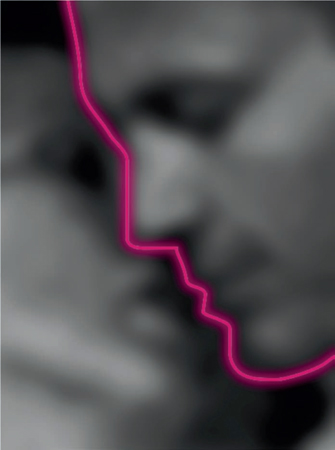
Ambiguous illusions occur when you can interpret a single image in more than one way. Many contemporary examples hark back to a simple sketch by the English artist William Ely Hill, titled My Wife and My Mother-in-Law, which was published in the magazine Puck in 1915. In 1930, the experimental psychologist Edwin Boring of Harvard University brought the illustration to the attention of psychologists around the world. Boring argued that unlike other ambiguous figures, such as the Face/Vase illusion—where a dividing line separates the left and right face silhouettes from the central chalice—the wife and mother-in-law depictions infiltrate each other without an obvious visual barrier between them. In Boring’s words, the drawing “shows in one figure the left profile of a young woman, three-quarters from behind. The other figure is an old woman, three quarters from the front. The ear of the ‘wife’ is the left eye of the ‘mother-in-law’; the left eyelash of the former is the right eyelash of the latter; the jaw of the former is the nose of the latter; the neck-ribbon of the former, the mouth of the latter.” Boring’s vivid description of the ambiguous face launched a thousand experiments in perceptual alternation. This research aimed to find out how it is possible for the same physical image to generate two distinct and incompatible perceptions, and what changes in neural activity underlie the back-and-forth switches between one interpretation and the other. Almost forty years later, the vision scientist Gerald H. Fisher introduced a third figure, representing an old man, to create a triple-ambiguous image.
BY GIANNI SARCONE, COURTNEY SMITH, AND MARIE-JO WAEBER
ARCHIMEDES LABORATORY PROJECT, ITALY
2011 FINALIST
This illusion was discovered in an old photograph of two lovers sent to Archimedes’ Laboratory, a consulting group in Italy that specializes in perceptual puzzles. Gianni Sarcone, the leader of the group, saw the image pinned to the wall and, being nearsighted, thought it was a single face. After putting on his eyeglasses, he realized what he was looking at. The team then superimposed the beautiful Venetian mask over the photograph to create the final effect.
This type of illusion is called “bistable” because, as in the classic Face/Vase illusion, you may see either a single face or a couple, but not both at once. Our visual system tends to see what it expects, and because only one mask is present, we assume at first glance that it surrounds a single face.

BY ROB JENKINS
UNIVERSITY OF GLASGOW, U.K.
2008 SECOND PRIZE
Not knowing where a person is looking makes us uneasy. That’s why speaking with somebody who is wearing dark sunglasses can be awkward. And it is why someone might wear dark sunglasses to look “mysterious.” The Ghostly Gaze Illusion, created by Rob Jenkins, takes advantage of this unsettling effect. In this illusion, twin sisters appear to look at each other when seen from afar. But as you approach them, you realize that the sisters are looking directly at you! The illusion is a hybrid image that combines two pictures of the same woman. The overlapping photos differ in two important ways: their spatial detail (fine or coarse) and the direction of their gaze (sideways or straight ahead). The images that look toward each other contain only coarse features, whereas the ones that look straight ahead are made up of sharp details. When you approach the pictures, you are able to see all the fine detail, and so the sisters seem to look straight ahead. But when you move away, the gross detail dominates, and the sisters appear to look into each other’s eyes. In another example of a hybrid image, a ghostly face appears to look to the left when you hold the page at normal reading distance. Step back a few feet, however, and she will look to the right.